I have some opinions on driving in America after a few years of doing it myself. Some of them would apply anywhere, some of them are certainly specific to America. I try to outline some situations where my opinions apply, and as such, there may be many drawings in this post.
I would also note I can't draw particularly well. So please excuse my rudimentary drawing abilities.
And as a disclaimer, this blog post reflects my current opinions. These opinions are not particularly well-thought-out, and may be factually incorrect.
Town Driving
The only three countries I've observed driving or driven in as a driver are Canada, the US, and the UK. In the UK, roads in suburban areas are very narrow and dense. Because the density is higher, and just to survive most situations you have to understand many suburban roads only have one lane, that needs to be shared by both directions of oncoming traffic.
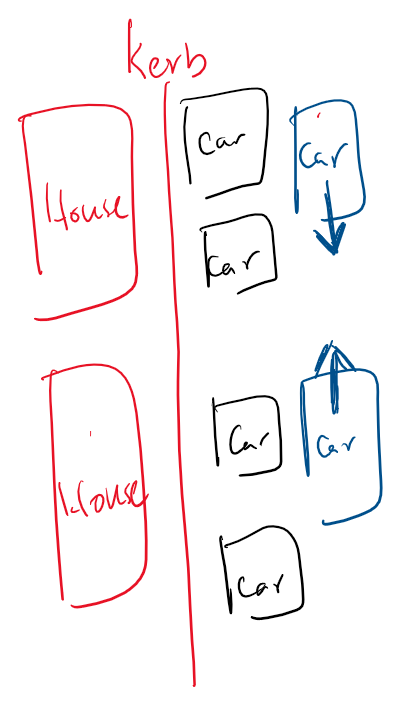
Effectively, if parked cars on the side of the road are in the direction that you are driving in, you must also park and give way to oncoming traffic!
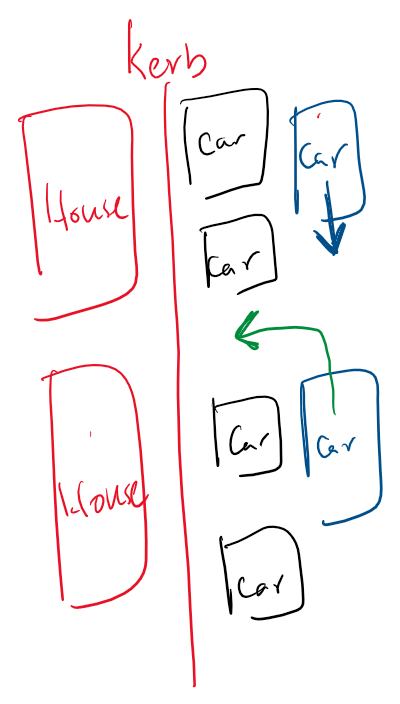
It would actually be helpful for this to be taught in America. I try to follow the British rule when driving in the US, although the cases of dealing with narrow lanes is quite rare. Additionally, roads are inherently wider in the US, so there is a chance there is only one lane of traffic and parked cars on both sides. In this case, what do we do? Maybe the British have a rule for this. I'm not sure.
Apart from that, I do not have as many complaints about suburban driving in the US. Many suburban areas were designed with driving in mind, and, as such, are easy and efficient to drive in.
2-Way Stops
2-way stops are just… dangerous. Not really for turning right, maybe for turning left, and probably for going straight. Most of the times I have encountered 2-way stops have been in dangerous situations. These include in cities where cars are parked on both sides of traffic which inhibits visibility (see City Driving section), and two-way stops at the top of a hill (which is to say, seeing cars coming from the left or right is extremely difficult).
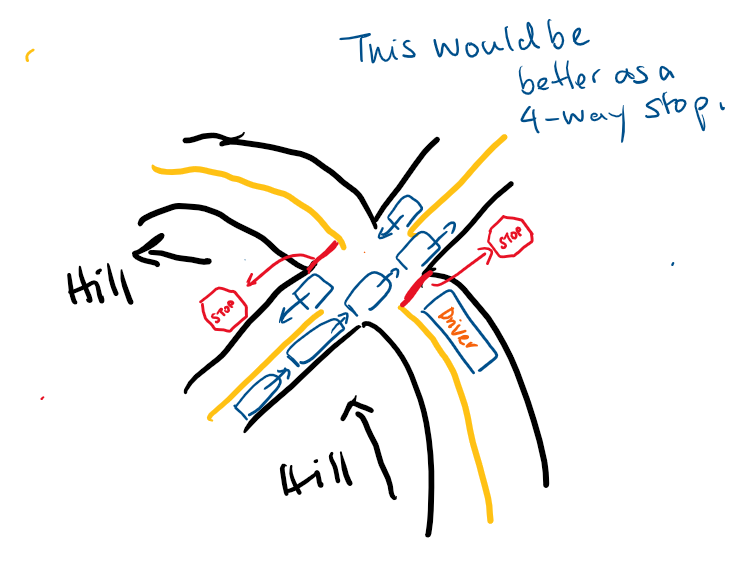
(I am terrible at drawing.)
Perhaps some of the discomfort with two-way stops are psychological, as many of the same checks have to be applied when making a left turn. I think the reason why it can be more difficult to judge a 2-way stop is because when turning left, you are able to turn your head in the direction of traffic, but when going straight, your head is focused straight ahead. This means it is difficult to react to whatever is happening with traffic that has the right of way when you are going straight.
Furthermore, there is likely a higher chance of being T-boned when going straight and failling the maneouvre compared to when turning left, as if you have already completed the turn then you will be rear-ended, which is ostensibly less dangerous.
4-Way Stops
4-way stops are like 2-way stops, but less dangerous. The reason for this is
You are not impeded by visibility issues because drivers are (supposed to) stop at the intersection, so you can see every car clearly
-
People are more familiar with the 4-way stop system in the US than the 2-way stop, so they will likely behave better.
Point 1 is probably the one that takes precdence. In reality, the very fact you can see every car at the intersection makes things about ten times clearer.
However, there are still plenty of problems with 4-way stops. Most of them pertain to order. Despite there being an official rule in the driving handbook on what to do when two people arrive at a 4-way intersection at the same time (yield to the person on the right), deciding who arrived first at a 4-way stop can be ambiguous, hard to judge, and contentious with impatient drivers.
Another issue is safety. If people actually stop at the 4-way stop, then the injury during an accident is likely minimized, as the intersection area is a low-speed zone. However, someone can be launching their Subaru WRX and not be paying attention to the stop signs, and then T-bone someone at 60 miles per hour. So the 4-way stop sign only minimizes danger if the drivers actually stop.
Even then, with the confusion, there is a higher probability of getting into an accident in the intersection area, even if it isn't a very dangerous accident. And I do not like accidents.
Why Roundabouts are Better
Which brings me to the solution to 4-way stop signs: roundabouts.
Roundabouts are superior. First of all, the risk of a fatal injury such as in the scenario I gave with the Subaru WRX is greatly minimized. When there is a roundabout, it is clear to the driver that they have to slow down, because in most cases it would not be possible to go straight over the circle in the middle of the roundabout. By slowing down, the risk of injury is minimized.
Furthermore, the rules for entering a roundabout are much easier to follow and much clearer as a driver, which minimizes the risk of confusion.
In essence, in the US, when entering a roundabout, you just look to your left, and see if there is enough space for you to enter the roundabout given the current cars in the roundabout. If there is space, you just go. You don't even have to come to a full stop if no one is there, which makes the efficiency of your driving faster. If there is no space, you wait until there is space, and then go.
The only reason why implementation would be difficult in the US is because drivers would not be used to roundabouts' ubiquity, which is not the best excuse but a valid one nonetheless. It would be helpful if more municipalities in the US adopted roundabouts for traffic control over both 2-way and 4-way stops, because it requires far less mental energy to use a roundabout (once you understand how they work), and also because of their increased safety.
Signaling Rules for Roundabouts
As far as I understand, in the UK, when entering a roundabout, you indicate the direction you are going (signal left if turning left, right if turning right, and no signal when going straight). However, when exiting the roundabout, you must signal left again to indicate you're exiting the roundabout (the UK drives on the left—if a similar rule were implemented in the United States you would end up signaling to the right).
Some indication of what is happening, if it isn't the exact same as the British way, would be helpful. When attempting to enter a roundabout, in the US, you would yield to the cars on the left, and then enter. Knowing when a car is going to exit the roundabout or keep going is very helpful to predict whether it is safe to enter the roundabout or not (depicted in the graphic below). Unfortunately, American drivers are not exactly accustomed to roundabouts, and as such, do not signal properly when turning into a roundabout, or exiting a roundabout. Of course, if we had a wider adoption of roundabouts in the US, we would be able to solve problems like this.
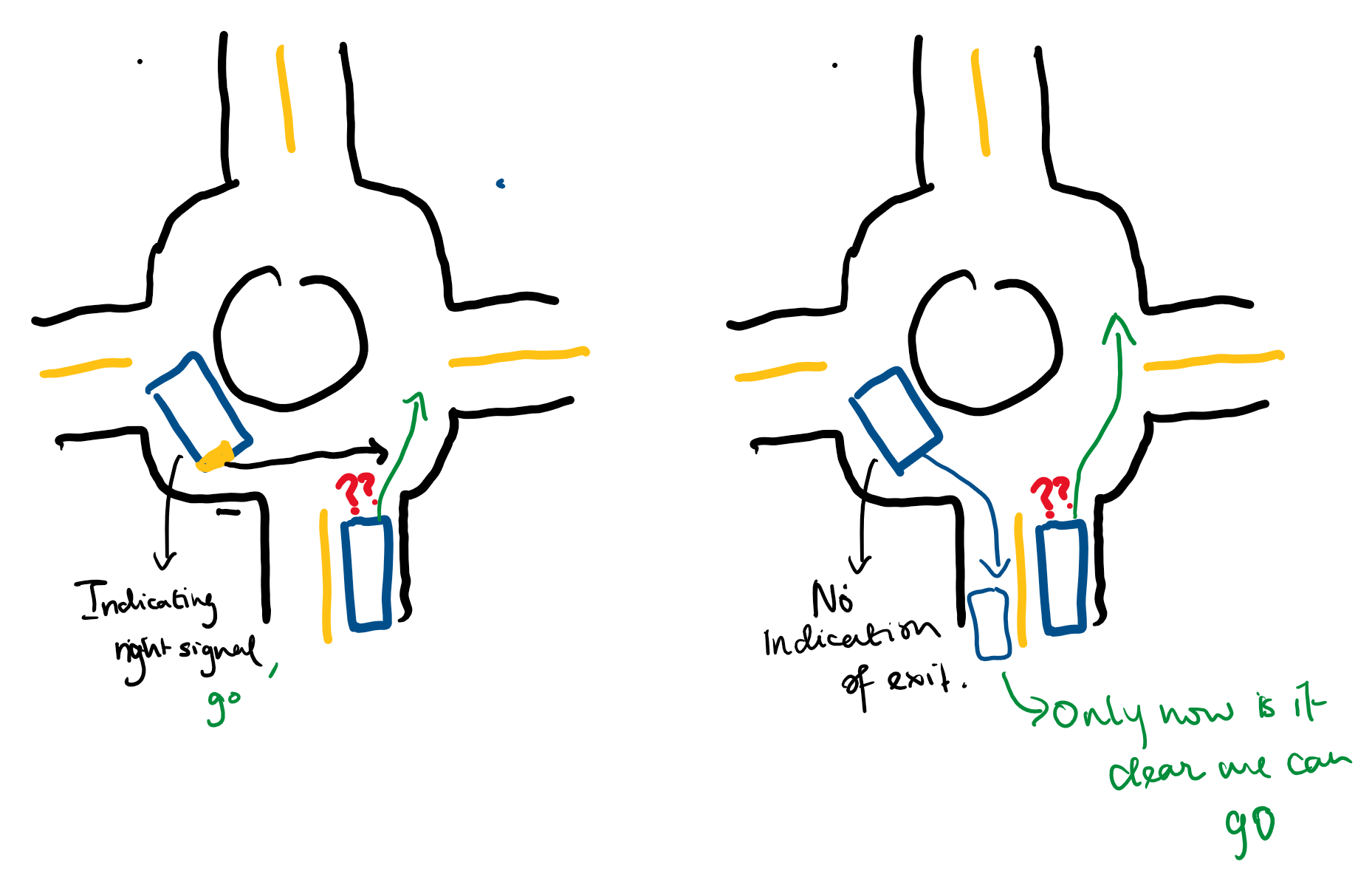
Of course, indicating can be useless. Some people will indicate one thing and drive in a completely different way. But at the minimum, it would be helpful to have additional information as a driver.
City Driving
2-Way and 4-Way Stops in Cities
To some extent, my comments on 4-way and 2-way stops also apply to city driving, except the magnitude is worse. That's because of the parallel-parked cars on the side of the road, which inhibits visibility. Suppose you're trying to go straight at a 2-way stop.

The driver might not be able to see the car in blue to the left so easily, simply because the parked cars block your view of what's coming. As a result, if you want to see what's going on, you have to pull forward, at which point you might be in the middle of the intersection, which is unsafe.
The only saving grace is that usually the speed limit in areas like these are 25 MPH, which makes it so you can go straight without really checking the road and be okay, since the other driver will probably see you and slow down.
But what if they're speeding? Then you're kind of done for. And that's the inherent anxiety in some of these E-way stops.
Pedestrians at Night
This isn't too hard. At most crosswalks, you have the usual MUTCD pedestrian crossing sign:

In fact, as long as you're paying attention, this is very easy to deal with. However, the visibility of the traffic signs at night may not be enough to get your attention. In some cases, it is likely more effective to put something like the British Zebra crossing (where the two orange globes alternate flashing).
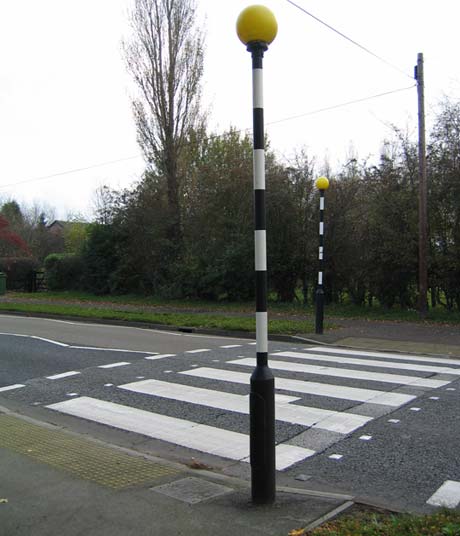
(Source: https://www.idgo.ac.uk/design_guidance/factsheets/Pedestrian_Crossings.htm)
State Routes
The Lack of Humanism
State routes in the US often are lined with stores, shopping centers, and things like that. When we go to the store, we have to get into our cars, and drive. Depending on where you live, you can't just walk to your nearby Walmart, or if you do, as pedestrian, you're not treated as a first-class citizen. You'll find cars whizzing by you at 50 miles per hour.
The fact that state routes like these foment the usage of cars is bad. It leads to further pollution, less human interaction (how are you going to interact with people when 90 of your time is spent in a car?), and overall makes America less humanistic.
This video, I believe, explains a similar point (but uses roads in Canada, which have the same problems as American roads).
Entering State Routes
Most of the time, this is not a big deal. But sometimes, there are issues, such as when Google Maps tells you to take a left onto a state route with a 40 MPH road—and there are no traffic signals.
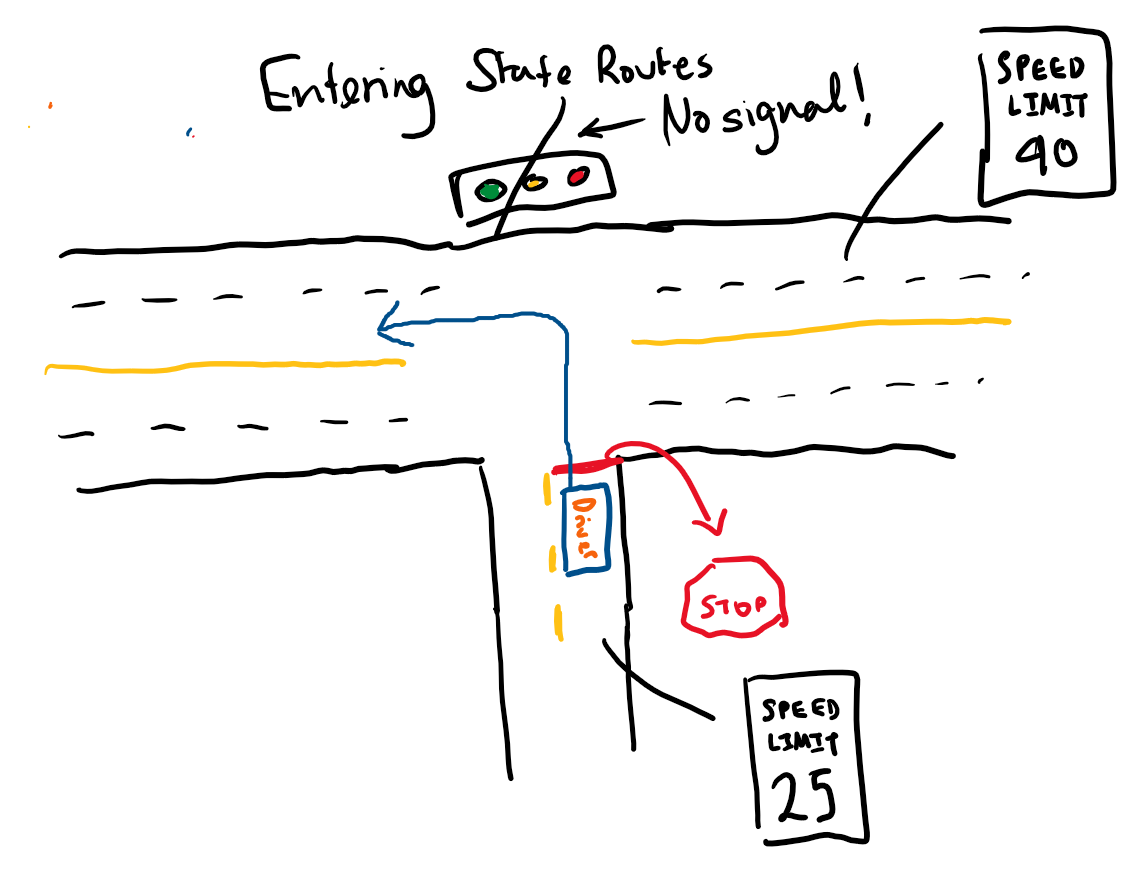
How is this allowed? You should only ever be allowed to take a right, if you're at all allowed to turn onto a state route like this. This might not be that dangerous if it's 40 mph, but the fact it has two lanes and there is inherently more traffic on a state route makes this dangerous. Furthermore, drivers do not tend to obey speed limits and increase their speed when driving in a state route.
I am sure this occurs where drivers have to turn left onto higher-speed routes, which is also really unsafe.
Highway Driving
The Left Lane
Before I start this section, I would like to emphasize I really like this video by Tedward. It really sums up the problem of the left lane in general, and highlights what is wrong with highway driving in the US.
Speed Limits and Efficiency
Speed limits seem pointless sometimes. That's not because they're not necessary in the US; they very much are. However, other countries do it better. For example, many sections of the German Autobahn do not have speed limits.
For the sake of efficiency, I would like to go from a point A to a point B as fast as possible. And sometimes I do not have such a time constraint. Perhaps I have a call I have to take from 11:00 AM, and I'm leaving at 10:30. It normally takes 45 minutes to get to my destination where I can take the call under normal highway traffic conditions. Well, if you follow speed limits in the US (as you should), you don't really have many options here.
But if there are no speed limits, you do have options. Because you can drive really fast in the left X lanes on the highway and make it to your destination faster. In an ideal world, you would be able to drive very fast in the left lane and go from point A to point B faster. It is implied that the left lane must only be for passing—you use the left lane to pass a few cars, and then must ultimately return to the lane to the right of that—but I have a different idea.
Unfortunately, there are a number of problems with traffic flow in the US that make it impossible to follow the idea of even passing in the left lane safely.
Dangerous/Problematic Situations
It's a common situation that American drivers do not pass a car while also being in the left lane. Here's a scenario where things become dangerous:
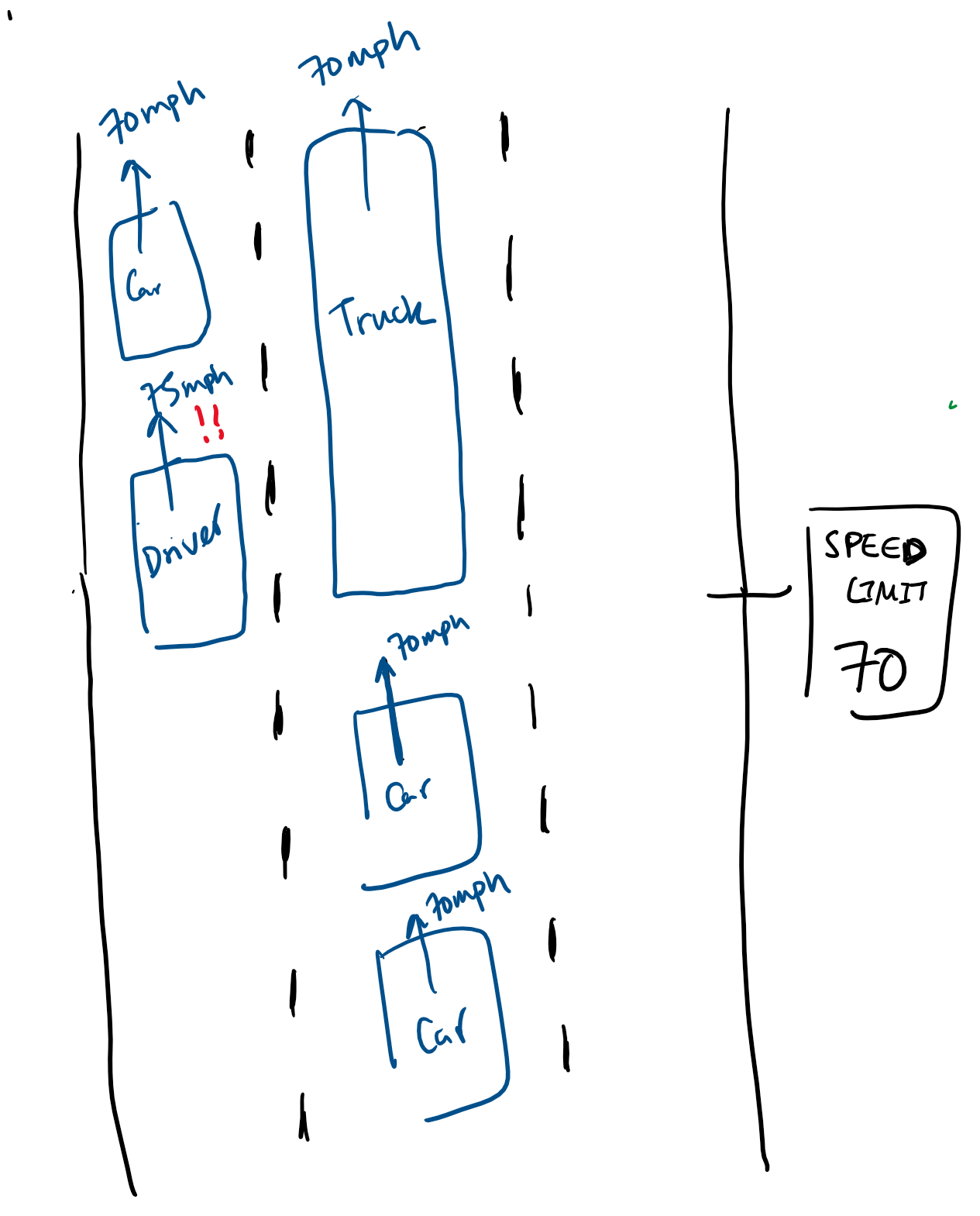
Because the car is stuck next to the truck, you must either slow down severely (go below the speed limit, which is inherently dangerous, especially in the left lane) to find a gap to move back to the right lane. Note that the cars in the left lane are travelling at the same speed at the cars in the lane to the right from the image, which is what causes the left lane to never overtake the right. From experience, that gap is not very easily found, and you must wait an order of minutes to find a gap to leave the left lane. What if you have an exit to take?
This same situation has another problem, which is that it now forces you to overtake the car stuck behind the truck by going to the right lane, passing the truck, and then switching to the left lane, if you would like to continue passing cars. Such situations impede the efficiency of highway traffic.
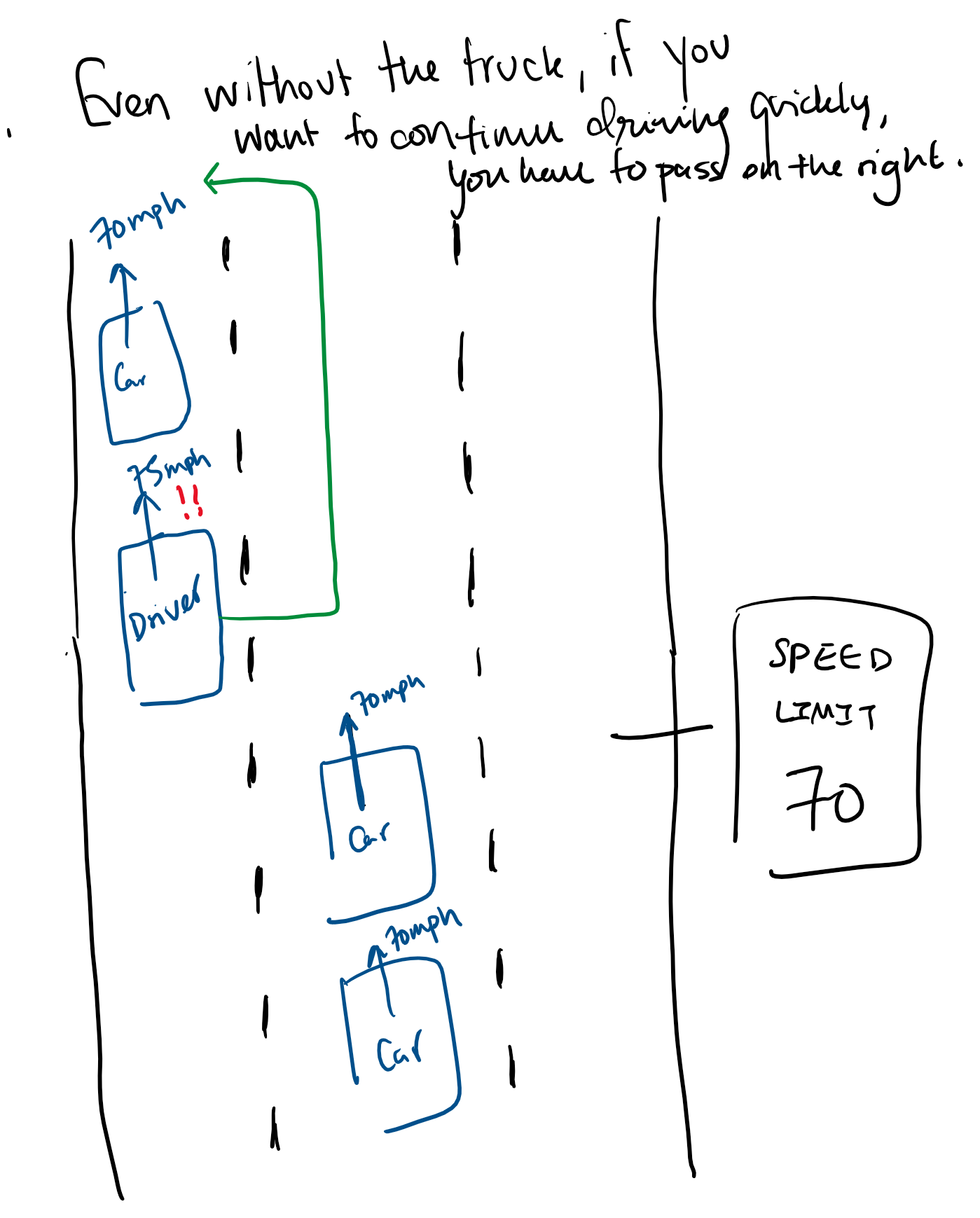
For the sake of efficiency, if you are trying to pass cars, sometimes, well, it's impossible to pass cars in the left lane legally. Obviously, no one should be passing on the right, but because of these problems it's impossible to pass on the left—you have to pass on the right.
Ideal Left Lanes
My idea of traffic in the left lanes is as follows:
- Every ten seconds, a car in a lane that is not the rightmost lane must pass at least 1 car in the lane right of it.
- If a car behind you is close to you (tailgating), or approaching at a higher speed, you cannot remain in the lane. Move right and wait for the car behind you to pass, then rejoin the lane.
- You can stay in a left lane however long you want, as long as you follow rule (1) and (2).
-
Exits from the Left Lane
Exits from the left lane are a bad idea, because they inherently break the rules of having a left lane—which is that left lanes should only be for passing. While this is totally infeasible, in an ideal world, it would be better to only exit from the right to preserve the integrity of traffic.
General Driving Thoughts
Lane Selection
Suppose you have to take a left into a two-lane road, and then take a right. While this sounds mayhaps niche, this is a much more common situation than you'd think at first glance.
Usually, when you take a left into a two-lane road, you have two "left turn" lanes before doing the turn. Well, most GPSes will tell you to "be in either of the left two lanes." There's a problem with that mentality, however. One lane is objectively better than the other, because if you're taking a right turn next, then you should select the rightmost of the two left turning lanes.
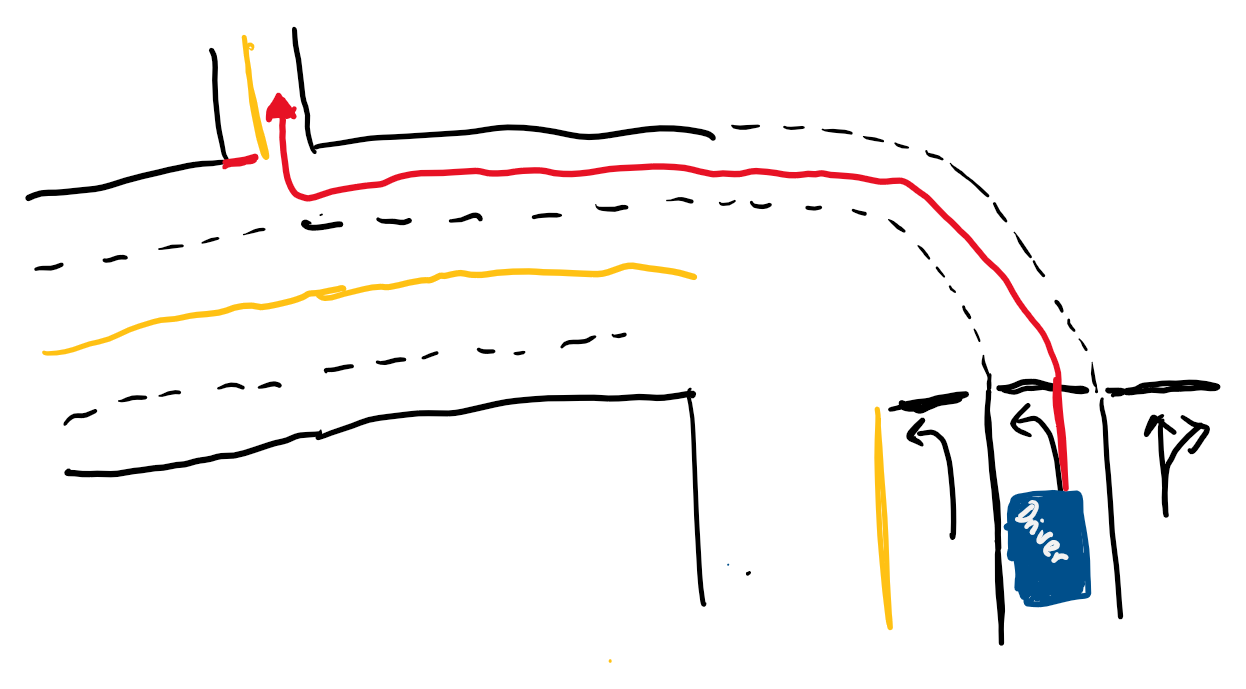
If you don't select the right lane, most of the time, it's fine. You can just switch lanes:
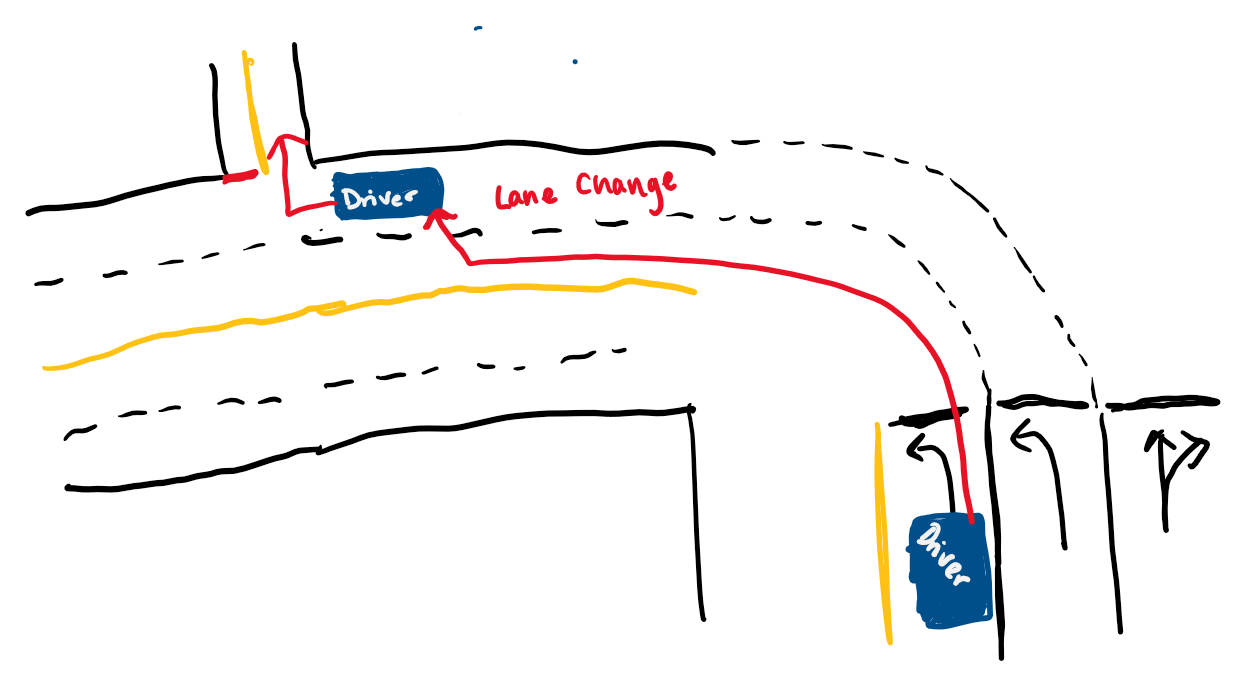
However, if you're driving somewhere for the first time, you might not know exactly where to position (and the GPS isn't helping), and during traffic it can also be inconvenient and dangerous to switch lanes. Lane selection is important.
On Highways
This also applies when driving highways. Why? Well, if you have an exit to take in less than 1 mile, you should really be staying in the right lane (or whatever lane the exit is). It removes stress from the drive. If you can't find an opening to switch to the right lane in that 1 mile, well, you have to take a different exit.
Tangentially related is the idea that people in the right lane should give way to people merging by moving to the left temporarily. This is something that British people do, and definitely helps for merging—especially perhaps something like trucks.
Stop Signs
While in many situations, you should always stop at a stop sign, it is technically not required to to be safe. At a 4-way stop, you should certainly come to a full stop. However, what if you have the following situation?
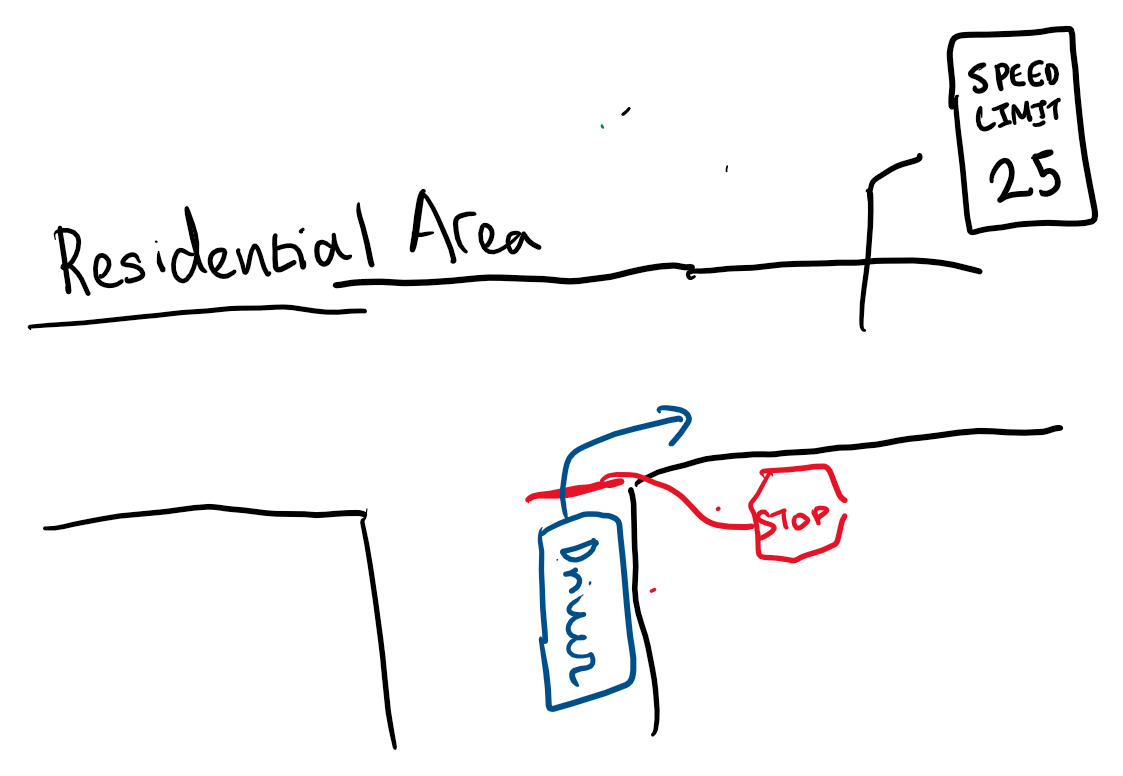
You don't really have to stop. You can do what's called a "rolling stop" because sometimes it's extremely obvious whether you can go or not. The fact that you have to stop when it's not actually necessary feels unnecessary. The UK has something called the "Give Way" sign:

(Source: https://www.conquerdriving.co.uk/images/give-way-sign.jpg)
The give way sign solves a lot of the problems I have with American stop signs. That's not to say there shouldn't be stop signs, but they are used in places where a Give Way would be better, such as the aforementioned scenario. With a give way sign, you don't have to stop, if you have enough visibility to see that you can go. So basically you can perform a "rolling stop" without its being illegal.
Public Transportation
While small parts of this blog post may have implied it, I am not a huge fan of cars. In fact, if public transportation were better, I would use it. But it isn't better. It's terrible in the US.
As Gabe Newell, the founder of Valve, said: "piracy is a service problem." For many, pirating movies is easier in than searching 20 different websites they pay subscriptions to. Anecdotally, video games are much easier for me to buy from Steam and play on Linux, because it's simply more convenient and easier to play, download, click play, and have everything work, than to find the video game online, spend 4 hours trying to set up Lutris correctly so it launches because there's only a Windows version, etc.
The same way, using public transportation won't be prevalent in the US because the service of public transport is worse. It's just less convenient. And so on.
But that's a blog post for another day.